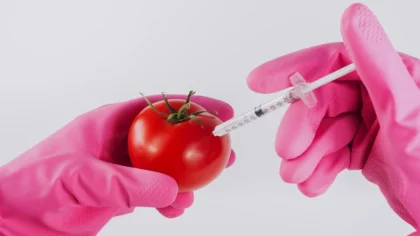Accelerate Productivity in 2025
Reignite Growth Despite the Global Slowdown
Our Innovation Analysts recently looked into emerging technologies and up-and-coming startups working on solutions for the biotechnology sector. As there is a large number of startups working on a wide variety of solutions, we decided to share our insights with you. This time, we are taking a look at 5 promising tissue engineering startups.
Heat Map: 5 Top Tissue Engineering Startups
Using our StartUs Insights Platform, covering 1.116.000+ startups & emerging companies, we looked at innovation in the field of biotechnology. For this research, we identified 156 relevant solutions and picked 5 to showcase below. These companies were chosen based on a data-driven startup scouting approach, taking into account factors such as location, founding year, and technology among others. Depending on your specific criteria, the top picks might look entirely different.
The Global Startup Heat Map below highlights 5 startups & emerging companies developing tissue engineering solutions. Moreover, the Heat Map reveals regions that observe a high startup activity and illustrates the geographic distribution of all 156 companies we analyzed for this specific topic.
Avery Therapeutics – Tissue Engineered Heart Graft
Traditionally, medical professionals treat cardiac blockages with the help of a vein from the leg or an inner chest-wall artery. As a result of advancements in tissue engineering, doctors tissue engineer the grafts to treat coronary heart conditions and help normalize the blood flow to the heart muscles. Emerging companies and startups are working on solutions and other techniques to use tissue-engineered grafts as a substitute for usual methods.
US-based startup Avery Therapeutics provides tissue-engineered solutions for medical professionals. MyCardia is an immunologically compatible tissue-engineered heart graft to treat coronary issues in humans and improve heart functions. This solution is in the pre-clinical development phase and additionally, the startup develops other innovative cardiovascular treatments as well.
Lattice Medical – Tissue Regeneration In Breasts
Bioresorbable materials are better than orthodox implants like titanium, stainless steel, and silicone. Tissue regeneration using bioresorbable materials, in comparison with surgical implants, helps with patient recovery in the long run. Foreign objects deteriorate inside our bodies and require continuous follow-ups while bioresorbable implants simply get absorbed. Moreover, such implants significantly reduce the frequency of medical checkups as well.
French startup Lattice Medical develops guided adipose tissue reconstruction solutions for breast regeneration. With the help of the Tissue Engineering Chamber (TEC), the startup engineers and creates a bioprosthesis that the adipose tissues of the patient completely absorb. The resorbable tissue regeneration techniques used by Lattice Medical help completely overcome traditional disadvantages like rejection and infection.
Cellular Logistics – Extracellular Matrix (ECM)-Enabled Tissue Engineering
Extracellular Matrix provides structural and biochemical support to surrounding cells and is a network of collagen, enzymes, and glycoproteins. ECMs provide the necessary environment for cardiac muscular regeneration. Additionally, ECMs and cardiac fibroblasts interact with cardiomyocytes, immune cells, and endothelial cells to help ECM deposition and enable tissue regeneration.
US-based startup Cellular Logistics builds an acellular biomaterial platform for cardiac tissue regeneration. The solution enables damaged tissue regeneration with the help of ECMs resulting in better cell therapy delivery and retention. As a first step, the startup is looking to apply this technique in cardiac cell therapies.
Biofabics – Biomaterials
To enable cell growth and cellular regeneration, biomaterials provide architectural structure for existing ECMs. The natural self-healing properties of tissues limit cellular regeneration based on the type of cells. Biomaterials like bio-ceramics and bio-glasses improve the structural strength, decrease biodegradation, and help ECMs to function to their fullest in cellular regeneration.
Portuguese startup Biofabics develops 3D printed bio tissue analogs. The startup creates the required cell structures by combining cells extracted from the host body and 3D printed biomaterials. These cell structures are tested in vitro with the help of bio-reactors that recreate tissue environments. This increases the success rate of tissue engineering and ensures that the patient receives optimal cell therapy.
Biomimetic Solutions – Nanomaterials For Tissue Engineering
In tissue engineering, nanomaterials enhance the mechanical, biological, and electrical properties of cells. These materials help improve cellular activities like adhesion, propagation, and segregation for tissue engineering. They also increase cell proliferation rates and electrical coupling of proteins in bones and cardiac tissues.
UK-based startup Biomimetic Solutions develops nanomaterials for tissue engineering applications. With the help of nanotechnology, organizations produce cell cultures and artificial tissues and use them in clinical trials and cell therapies for treating damaged or recovering tissues. The current focus of the startup is to recreate functional human organs and tissues with the help of nanomaterials.
What About The Other 151 Solutions?
While we believe data is key to creating insights it can be easy to be overwhelmed by it. Our ambition is to create a comprehensive overview and provide actionable innovation intelligence so you can achieve your goals faster. The 5 tissue engineering startups showcased above are promising examples out of 156 we analyzed for this article. To identify the most relevant solutions based on your specific criteria, get in touch.








